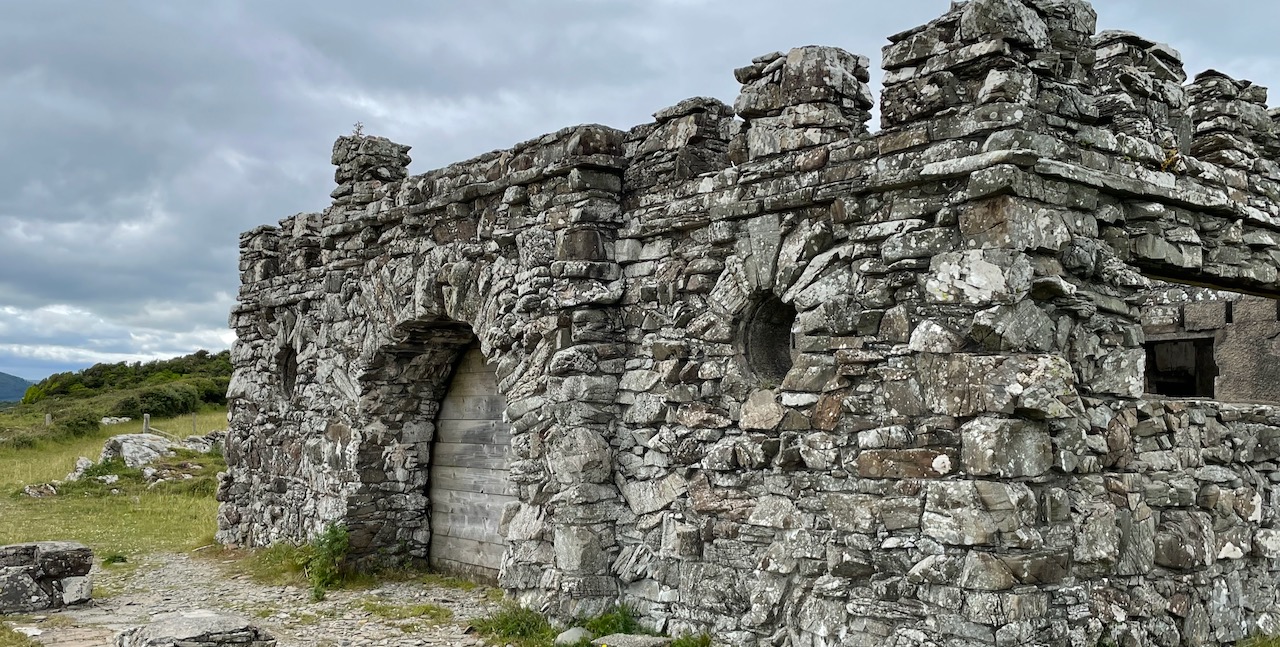Ron and I visited the British Museum last summer and spent some time in an exhibit called “Collecting the World,” which attempted to explain how the museum acquired its massive collection of artifacts, representing the best achievements of human civilization. Well, you could sum up the exhibit in one word: empire. The British Museum is a shrine to the power of empire—to steal, to conquer, to dominate—all of that. But also to create major public goods, like a free public museum packed to the marble cornices with historical and educational treasures, curated for all to see.
Empire, for all its legacy of evil, has its benefits. That’s the complexity of it. You might know that famous scene in Monty Python’s Life of Brian which makes the same point. A group of hapless Palestinian rebels (supposedly during the time of Jesus’ ministry) gather to plan their resistance to those nasty Romans, getting themselves revved up by asking, “What have the Romans ever done for us?” Despite themselves, they have to admit that the Romans have brought sanitation, roads, baths, medicine and so on. The Pythoners are spoofing the Roman empire, but they’re obliquely pondering the British empire’s legacy, too.
I’m not defending empire. Far from it. Instead, I’m trying to grapple—as we bloggers have been invited to do—with Syd Hielema’s thought-provoking essay, “The Church of Jesus in 2047,” published December 12. We are living at a time of great upheaval, where the sins of empire are visited on the whole earth and all its creatures. We are living at a time of empire shift, perhaps empire disintegration. Syd bravely and creatively tried to imagine what this time of upheaval might mean for the church. How might the church respond? What could the practice of Christian faith look like in 24 years?
By now, we’ve seen responses to Syd’s piece from Wes Granberg-Michaelson, Jason Lief, Laura DeJong, and Tim Van Deelen. I would like to add some tentative observations, though I feel embarrassed, in doing so, at my own limited perspective. We’re all speculating here, I guess, with the understanding that the speculation is itself a process of hope: what do we long for? what outcomes can we imagine and, through that imagining, help enact?
First, I have to agree with Tim Van Deelen that when Syd posits a “Decade from Hell” after which we find a new stability, Syd is being overly optimistic. Based on climate modeling projections, as Tim writes, “The church of 2047 will not be enjoying the recovery. It will be in the thick of the battle.”
We live on a changed earth. For some receipts on this point, you might look at the chart on p. 18 in the IPCC AR6 report, which outlines the increasing number of severe weather events we can expect at various degrees of warming. Note that we are already at 1.1°C over pre-industrial levels, and if we’re very determined and very lucky, we could possibly limit warming to 2° by 2100, which still entails far more volatility than we are already experiencing. Even if we do manage to reduce GHG emissions along the best-case scenarios and move quickly toward a renewable energy economy globally, we can still expect baked-in ocean rise that will severely disrupt coastal regions across the globe—where one-third of the human population lives.
The results of all this climate disruption, as Syd acknowledges, will be mass migration and the destabilization of economies, governments, agriculture, ecosystems. Syd posits some hope in UN endeavors to help curb the worst outcomes of all this volatility, and I hope that’s true. As David Hoekema mentioned in a comment on Syd’s piece, Kim Stanley Robinson’s “nonfiction novel” Ministry for the Future also gives the UN a key role in helping to manage the worst of global instabilities. (I also highly recommend this book—an experiment in imagining a realistic best-case scenario.) In any case, it might be more helpful to imagine, not a Decade from Hell, but a long-term “punctuated equilibrium”—or a punctuated, shifting equilibrium—where the punctuations are varyingly severe.
So like everyone else, Christians will have to be flexible, resilient, adaptive people. Syd’s taxonomy of builders/protectors/includers is helpful here. We can appreciate what the builders did in generations past, but trying to protect a status quo at this stage is futile. As Jason suggested, we can see in today’s protectors a terrible anxiety over frightening change they cannot control: “The rhetoric of remaining faithful to biblical truth masks a deeper fear and insecurity about social and cultural change.” As Wes noted, we have already been watching the disintegration of the denominational model, a shift to the church’s center in the global South, and the rise of Pentecostal and charismatic modes of Christianity.
These shifts, we might say, mark the demise of the Church of Empire. The church of empire is synonymous or at least deeply entangled with political power. It exists to perpetuate itself, to control an ever-increasing domain of people and institutions, to eliminate or suppress that which does not conform to its rules. We have to admit that the church of empire has its benefits, however. Institutions provide stability, identity, achievement. Imagine the cathedrals of Europe and the art, music, and educational excellences of an established, powerful church. It’s understandable that some people are reluctant to let that vision go.
If we are watching the church of empire break up, what comes next? Perhaps we could call this the Church of Refugia—refugia being that biological term for places of shelter where life endures amid crisis. Both Syd’s and Wes’s imagined scenarios hint at the church of refugia model. Wes predicts that “Sacramental life and embodied spiritual practices, far more than rational formulas or fearful boundaries, will define the church of 2047.” Syd’s imagined church is made up of inclusive, hyper-local house churches, loosely organized, service-oriented and connected with others through technology. These all seem to me reasonable features of a post-empire church model.
However, I don’t want to over-romanticize a refugia model. It comes with problems of its own. So I want to pose a couple key questions to further our communal wonderings.
What is the gospel?
Syd suggests that his characters were attracted to the little house church by the “gospel’s winsomeness,” but what is the gospel’s winsomeness in the context of a planet in crisis? The rise of the “nones” demonstrates that the old shorthands—“Jesus saves you from your sins”—are too individual and abstract for our historical moment. Thus I would suggest that one of the church’s most urgent tasks right now is to recover the creational practicality of the gospel. We witness to the gospel by engaging in literally healing the earth and its creatures, including humans, from the results of our very tangible sins of greed and injustice. We engage in agricultural reform, ecosystem repair, environmental justice work, the literal sheltering of refugees, economic reforms, the practical building of local communities reimagined for the thriving of people, creatures, soil, plants. We are much more than a group trying to convince others to adhere to a list of beliefs and “come in” to the church. We are—as Pope Francis has suggested—laborers in a “field hospital,” out in the world engaged in healing both spiritual and physical ills, wherever that healing is needed. This is far more than charity—it’s survival for all of us. For this, we will need to lean hard on our sacramental theology and practice.
We might also rediscover the gospel as defiance in the face of death. When life is pretty good—as it is for affluent Christians—we depend less urgently on the promise of the resurrection. When death and loss are in our face every day, then Jesus as the one who conquers death and gives life the last word: that is something we cling to fiercely.
And we might lean hard into the gospel as the fulfillment of God’s deep longing for the renewal of a gorgeous creation. We have a grand theological tradition of mapping our wonder and awe to God as creator, sustainer, redeemer of all life. We can practice and cultivate that wonder and awe in ourselves and others and thereby increase our shared longing for God’s fulfillment.
Who is “we”?
We have wasted so much energy drawing boundaries and defining who is in and who is out, fighting with one another, refusing to work together because of this or that difference. The enormous task of healing and adaptation ahead of us, however, will demand extreme humility and willing partnerships with non-Christians. Wes mentions more flexible affiliations and networks within Christianity. Yes, but I also imagine a future in which Christians—as a matter of course—engage in a lively network of partnerships across faiths and civic organizations. Interestingly, I think the pandemic may have jolted us into learning the technological tools that make these partnerships vastly more feasible. It’s nothing now to have meetings with people online from around the world. Our nodes of connection proliferate.
These partnerships might be organized at broader regional or even global levels, but the most important outcomes will be realized locally. Imagine, for example, two Christian congregations partnering with a mosque, a tribal government, and the county government to heal a watershed and reform zoning laws to eliminate industrial pollution and build low-income housing. “We” as Christians have to be willing to learn from other wisdoms to correct our distortions and blind spots. And we have to get out of our self-imposed lanes and work with others. After all, nothing creates community better than a shared, meaningful task.
Speaking of community, this is something we will need to relearn. Syd’s vision of small house churches actually worries me. Small groups are so fragile. Conflicts arise, betrayals happen. And Americans, at least, are terrible at community. We are formed as consumers with preferences, not communal citizens ready to sacrifice for the common good. Church community has never been easy, but we need it more than ever. I love Wes’s idea of new religious orders as one possible model among many. But I fear we will have to engage in difficult training regimen in order to develop the tough community sinews we will need.
How do we pass on the faith?
Syd mentions that his imagined characters’ “Reformed roots gave them a rich capacity of nuance and depth,” but also imagines that leadership will be formed, not through institutional processes but through mentorship. Wes mentions seminaries but with a question mark about their continued role. I wonder: how do we teach the next generations? Here’s where established institutions have an advantage. They preserve a legacy. Yes, that comes with the dangers of ossification, suppression of dissent, an obsession with preserving the museum rather than addressing current realities. But how is someone supposed to learn nuance and depth unless there are people and institutions charged with preserving the best of the tradition—and remembering past mistakes so we don’t repeat them? If teaching and training devolves entirely to mentorship and the local, I wonder what distortions we might end up with and what further fractures among us. The Reformed tradition at its best is deeply suspicious of the powerful personality, or what we would now call “the person with the platform.” So this is a genuine question: how do we pass on the best of our legacy? How do we say: “Here’s what we’ve learned over the long haul, all of us together. Now you go and adapt this to the future”?
There’s so much we don’t know about what’s coming. I pray, earnestly, for mercy and wisdom as we muddle through, dependent as ever on grace. I hope that by engaging in these speculative exercises, we can more readily receive whatever wisdom God is pleased to grant.





